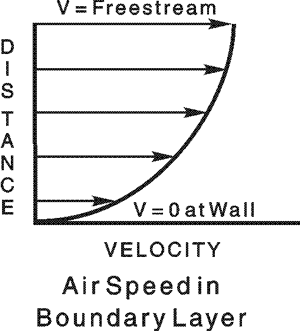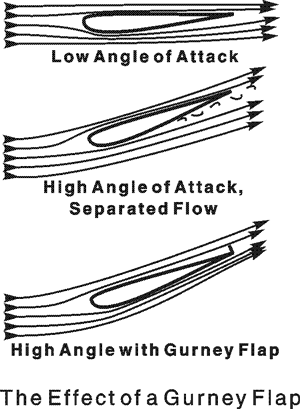INSIDE
RACING
T E C H N O L O G Y
IRT Home
IRT Home
News Page
Contents Page
Newsletter &
Books
email Paul
Boundary Layer
The Boundary Layer
To most of us air is just there. Although we can't survive more than a couple of minutes without it, we take it for granted. Airflow, actually, is pretty simple as long as you travel at a walk or a human r0un or even at the speed of a galloping horse. But, if you're designing or racing motorcars, air is a big challenge. One of the challenging characteristics of fluid flow is the boundary layer.

The boundary layer is a simple concept--when a fluid flows next to a fixed surface, friction slows down the air molecules close to that surface. If you measure the speed of the air right at that surface, you'll find the air is still; its velocity is zero, as in the graph. If you measure further out from the wall, you'll see increasing speed until it reaches the maximum speed, which is called the free stream velocity. A difference in flow velocity across a fluid stream means there is shear--differences in speeds between adjacent parts of the stream. If the fluid is a viscous material, as all real-world fluids are, then shear means friction losses in the flow and that's where things get complicated.
Freeway Analogy
Here's a familiar analogy to demonstrate a viscous fluid boundary layer. Let's say you're driving your car on a crowded freeway with four lanes in your direction. Cars in the left lane are moving at about 60 mph and are spaced out comfortably with six or seven car lengths in between each vehicle. But the far right lane is completely stopped because of a constant stream of cars coming onto the freeway from a crowded on-ramp.
Upstream of the on-ramp the cars in the right lane are close-packed bumper to bumper, almost stopped. That creeping right lane slows cars in the lane next to it because drivers aren't comfortable whizzing by stopped cars, and also because drivers in the right lane are pulling out into the second lane in an attempt to make some progress. This drags down the speed of the second lane which, of course, means those drivers try to move into the third lane, which drags down its speed also.
If you were to stand on an overpass and get the big picture on this situation you'd see a dense, almost stopped right lane and a loose, speedy left lane. In between, the second lane is moving a little faster than the right lane but is dragging down the speed of the third lane. The reluctance of drivers to travel a lot faster than an adjacent lane is analogous to friction in a viscous fluid. The vehicle velocity profile across the road would look like the graph.
Bernoulli
We talked about Bernoulli's Theorem in the Race Tech 101 page, learning that Total Pressure, the sum of Static Pressure and Dynamic Pressure, is a constant in any fluid. A fluid gains dynamic pressure as it speeds up and has to lose static pressure to keep the sum the same. The spacing of the cars on the freeway is analogous to dynamic pressure. In the fast lane the cars are strung out but, as the speed decreases in lanes to the right, the spacing closes up just as the dynamic pressure decreases in a fluid.
In a real-world freeway situation, a driver in the right lane seeing a crowded on-ramp ahead would (if the driver was paying attention) change lanes to avoid slowing down. The driver senses a pressure increase ahead. If changing lanes is difficult, the driver is forced to slow and now wants to change lanes even more. That's higher pressure!
When an air molecule slows almost to a stop because it's up against a boundary wall, it might encounter a completely stopped molecule in front of it at a slightly higher pressure. Air flows away from a higher pressure so the moving molecule moves away from the wall and gets in the way of a molecule going a little faster than itself. The slow, higher-pressure molecules in front may actually move against the flow and reverse direction. This is what causes circular eddies in boundary layer flow. You can see something similar in smoke rising from a cigarette (do people still do that?) and in water flowing around rocks.
Flow Separation
As you can see from the freeway analogy flow separation is caused by a reverse pressure gradient due to air slowing next to a fixed boundary. You don't have separation when air is accelerating as on the front of a moving vehicle where the flow is still attached to the surface. It's on the back of the car, where you have the air slowing down, that you get separation and the drag that goes with it.
Racecar designers fight flow separation in three main ways-gradual transitions, spoilers, and creating turbulence. At the rear of the car after the maximum body cross section, body-panel angles are kept small, less than 10 degrees. This gives the familiar teardrop, streamlined shape.

If a large transition is needed a lip can spoil the air into the low-pressure area lowering drag. Look again at these sketches illustrating what a Gurney does. Air flowing over the bottom of a wing at low angles of attack speeds up over the thick part of the wing and then slows down until, at the trailing edge, it's at the same speed as the air that went over the top of the wing. As the air slows down, its static pressure rises and the boundary layer thickens. At higher angles of attack, the boundary layer can develop well enough to generate eddies and flow separates from the surface. When you have separated flow, as in the top sketch, drag goes up and the wing can stall.
A Gurney flap allows a wing to operate at higher angles of attack than the same wing without a Gurney. Look at the streamlines on the Gurney sketch. You can see the air has to move up to go around the Gurney lip. That creates a lower pressure right behind the flap that translates around the corner to the bottom of the wing. This guarantees a high-to-low pressure gradient along the bottom of the wing and prevents separation. This is why you see a lip on the back of almost every shape on a racecar.
The third drag-lowering device is turbulence. If the air close
to a fixed boundary is swirling, at any moment some of it is
moving toward the boundary making separation more difficult.
When you see vanes and barge boards on a racecar think about
how the air sees this obstacle and tries to move from areas of
high pressure in front toward lower pressure behind the feature.
Often the result is a turbulent, swirling motion that sweeps
along the body panel retarding separation.